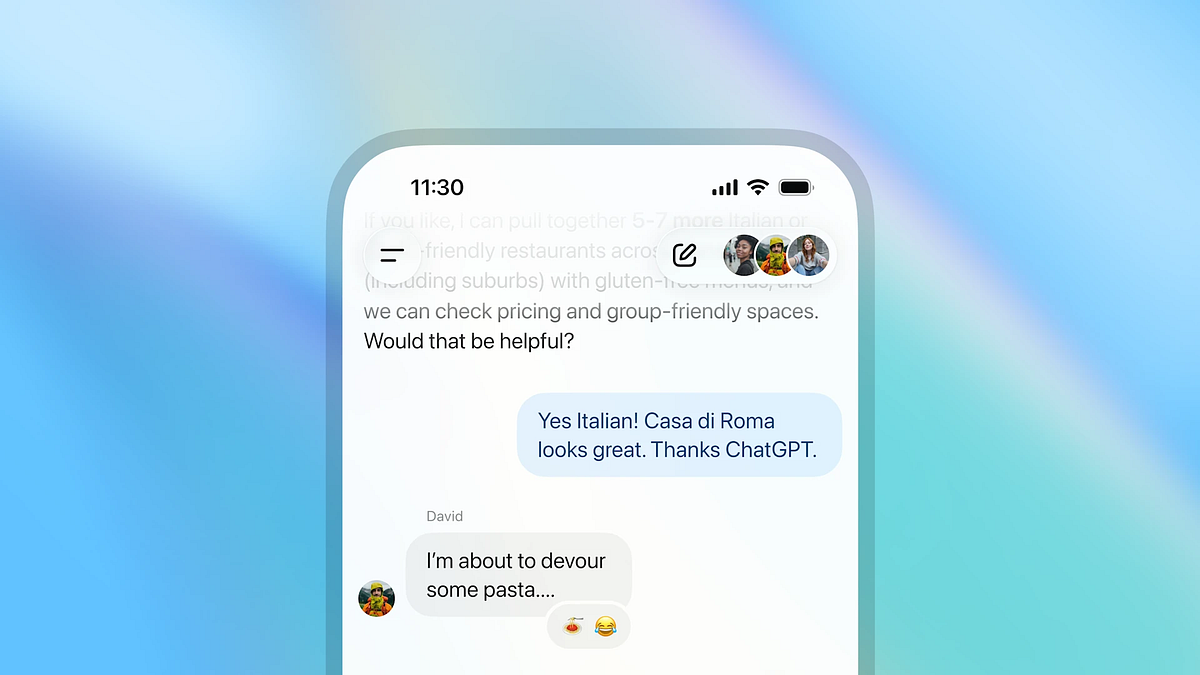Multiple users can now collaborate seamlessly with ChatGPT in shared conversations!
OpenAI has officially unveiled a pioneering addition to its conversational AI ecosystem: ChatGPT Group Chat. This innovative feature, now in limited pilot release, enables multiple users to interact with ChatGPT simultaneously within a shared digital space.
The rollout signals a strategic expansion beyond individual ChatGPT sessions, positioning the technology as a collaborative platform rather than merely a personal assistant.
Industry analysts note this development could fundamentally reshape how teams and social groups integrate AI into their daily workflows and interactions.
What is ChatGPT Group Chat?
The ChatGPT Group Chat feature creates a shared environment where multiple users can interact with both each other and AI simultaneously. According to OpenAI’s product team, this represents “a new paradigm in human-AI collaboration,” designed to enhance rather than replace human interaction.
One of the most sophisticated aspects is the AI’s contextual awareness. ChatGPT Group Chat intelligently determines when to contribute naturally to conversations and when to remain observational. However, users maintain control — simply tagging @ChatGPT ensures immediate attention to specific queries or requests.
The platform also supports richer interaction modes beyond text. Participants can use emoji reactions, reference each other’s avatars, and even request customized visual content.
Early testers report that these features make conversations feel more natural and engaging compared to traditional chat platforms.
Read More: GPT-5.1 Officially Launches
How to Use Group Chat in ChatGPT: Step by Step
Setting up and using the new group feature follows an intuitive process:
- Platform Access: Begin by navigating to the ChatGPT web application and ensuring you’re logged into your account. The feature is accessible across subscription tiers from Free to Pro.
- Navigation: Look for the “Start a Group Chat” option prominently displayed in the top navigation bar. The interface has been updated to make this feature easily discoverable.
- Initialization: Clicking the button immediately generates a new group chat environment. The system automatically configures the space with optimal settings for multi-user interactions.
- Link Generation: Each new group receives a unique, shareable URL that serves as the access point for all participants. This link remains active throughout the group’s existence.
- Invitation Process: Share the generated link through preferred communication channels — email, messaging apps, or collaboration tools. There’s no theoretical limit to how many people can be invited, though practical constraints may apply.
- Joining Mechanism: Participants access the group by simply clicking the shared link. The system handles authentication automatically based on individual user accounts.
- Immediate Participation: New members enter the conversation stream instantly, with full access to current and past discussions from their entry point forward.
- Historical Context: Unlike some group platforms that limit historical visibility, ChatGPT Group Chat allows latecomers to scroll through the entire conversation history, ensuring everyone operates with complete context.
Who can use Group Chat now?
Availability is currently limited to specific regions as part of OpenAI’s controlled rollout strategy. Users in Japan, New Zealand, South Korea, and Taiwan can access the feature across all major ChatGPT subscription levels — Free, Go, Plus, and Pro plans.
The phased approach allows OpenAI to monitor performance across different network environments and usage patterns. Company representatives indicate they’re particularly interested in how cultural differences might influence feature adoption and usage patterns across these initial markets.
OpenAI has confirmed that expansion plans will be data-driven, with rollout to additional regions depending on technical performance and user feedback from these pilot markets. The company expects to announce additional regions within the next quarter.
Use cases of ChatGPT Group Chats
Enhanced Team Collaboration
Modern remote and hybrid teams are finding ChatGPT Group Chat particularly valuable for structured collaboration. During strategy sessions, the AI can track action items, suggest alternatives based on industry best practices, and even help resolve disagreements by providing objective data.
Project managers report that meetings become more productive when ChatGPT handles note-taking and summary generation in real-time, allowing human participants to focus on creative problem-solving.
Social and Entertainment Applications
Beyond professional use, social coordinators are leveraging the platform for event planning and community management. Book clubs can discuss readings with ChatGPT providing author background and discussion questions. Gaming groups can organize sessions while the AI suggests strategies or resolves rule questions.
The system’s ability to generate custom images based on participant avatars has proven especially popular for creating personalized memes and inside jokes.
Educational Environments
Academic institutions are experimenting with ChatGPT Group Chat for both classroom and research applications. Study groups benefit from having an always-available tutor that can explain concepts from multiple perspectives.
Research teams use the platform for literature review sessions, where ChatGPT can quickly pull relevant studies while human researchers focus on critical analysis and connection-making. The platform’s ability to document the entire conversation provides valuable records for institutional knowledge preservation.
Final Words on ChatGPT Group Chat
The introduction of ChatGPT Group Chat marks a pivotal moment in conversational AI development.
Rather than simply scaling existing technology, OpenAI has reimagined how artificial intelligence can function within human social structures. This represents a shift from AI as a transactional tool to AI as a collaborative participant.
Industry observers note that the timing coincides with growing demand for more sophisticated digital collaboration tools. As remote work and distributed teams become permanent fixtures, solutions that seamlessly blend human and artificial intelligence may become essential rather than optional.
Follow me for daily updates on the latest breakthroughs in AI!
